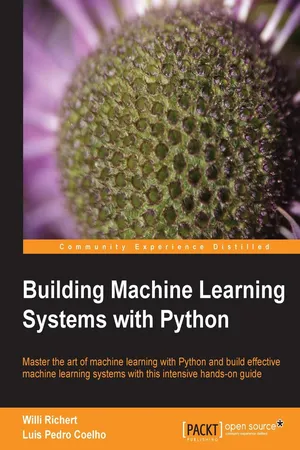
- 290 pages
- English
- ePUB (mobile friendly)
- Available on iOS & Android
Building Machine Learning Systems with Python
About this book
In Detail
Machine learning, the field of building systems that learn from data, is exploding on the Web and elsewhere. Python is a wonderful language in which to develop machine learning applications. As a dynamic language, it allows for fast exploration and experimentation and an increasing number of machine learning libraries are developed for Python.
Building Machine Learning system with Python shows you exactly how to find patterns through raw data. The book starts by brushing up on your Python ML knowledge and introducing libraries, and then moves on to more serious projects on datasets, Modelling, Recommendations, improving recommendations through examples and sailing through sound and image processing in detail.
Using open-source tools and libraries, readers will learn how to apply methods to text, images, and sounds. You will also learn how to evaluate, compare, and choose machine learning techniques.
Written for Python programmers, Building Machine Learning Systems with Python teaches you how to use open-source libraries to solve real problems with machine learning. The book is based on real-world examples that the user can build on.
Readers will learn how to write programs that classify the quality of StackOverflow answers or whether a music file is Jazz or Metal. They will learn regression, which is demonstrated on how to recommend movies to users. Advanced topics such as topic modeling (finding a text's most important topics), basket analysis, and cloud computing are covered as well as many other interesting aspects.
Building Machine Learning Systems with Python will give you the tools and understanding required to build your own systems, which are tailored to solve your problems.
Approach
A practical, scenario-based tutorial, this book will help you get to grips with machine learning with Python and start building your own machine learning projects. By the end of the book you will have learnt critical aspects of machine learning Python projects and experienced the power of ML-based systems by actually working on them.
Who this book is for
This book is for Python programmers who are beginners in machine learning, but want to learn Machine learning. Readers are expected to know Python and be able to install and use open-source libraries. They are not expected to know machine learning, although the book can also serve as an introduction to some Python libraries for readers who know machine learning. This book does not go into the detail of the mathematics behind the algorithms.
This book primarily targets Python developers who want to learn and build machine learning in their projects, or who want to provide machine learning support to their existing projects, and see them getting implemented effectively.
Frequently asked questions
- Essential is ideal for learners and professionals who enjoy exploring a wide range of subjects. Access the Essential Library with 800,000+ trusted titles and best-sellers across business, personal growth, and the humanities. Includes unlimited reading time and Standard Read Aloud voice.
- Complete: Perfect for advanced learners and researchers needing full, unrestricted access. Unlock 1.4M+ books across hundreds of subjects, including academic and specialized titles. The Complete Plan also includes advanced features like Premium Read Aloud and Research Assistant.
Please note we cannot support devices running on iOS 13 and Android 7 or earlier. Learn more about using the app.
Information
Building Machine Learning Systems with Python
Table of Contents
Table of contents
- Building Machine Learning Systems with Python